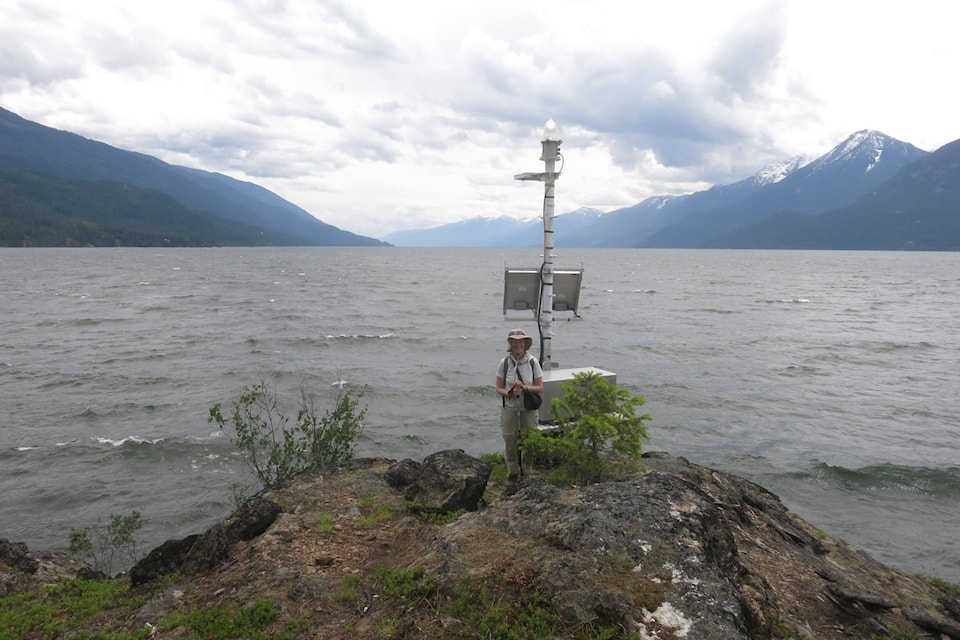By Ed McMackin, a biologist by training and a naturalist by nature
One can’t really talk about the natural landscape from Meadow Creek to Creston without talking about Kootenay Lake and its influence on the land, forested mountains, steep-sided valleys, and many creeks.
Kootenay Lake, in the Central Kootenays, because of its large size, has a unique influence on the surrounding land, more so than Slocan Lake and Arrow Lakes, in the West Kootenay, have in their respective areas. It is said that it is 104 kilometres long and five kilometre at its largest width, giving an area of 400 square kilometres. A comparable lake in the West Kootenay, Slocan Lake has an area of about 69 square kilmetres. The Arrow Lakes are a result of the flooding of the Columbia River by Hugh Keenleyside Dam in 1968. So, Kootenay Lake has the greater influence on the land because of its larger surface area.
Another different feature of the Kootenay Lake Region are the extensive valley bottoms, flats at the south end of Kootenay Lake, which extend into Idaho state clear to Bonner’s Ferry. Periodically, these flats and the meadows at the north end of the lake were flooded, a natural event that enriched the soil with nutrients. Evidence indicates that at one time Kootenay Lake extended to Bonner’s Ferry.
Also, because of the large flat lake area and the extensive flat valley bottoms, winds have a clear, unobstructed path over which to reach their optimum speed.
One can easily understand that the large area of Kootenay Lake increases, with the help of prevailing south-west winds, the humidity of the east shore of Kootenay Lake all the way from Meadow Creek to Boswell in the south. When the winds come from the north west, then the humidity level at the south end of the lake is raised. In summer, the higher humidity along the lake can make the air feel warmer, and during the rest of the year, make the cold feel more intense. The temperature of the lake also affects the temperature of the land, especially down wind from the prevailing air currents. In spring, it may keep the land cooler, while in the fall it may keep it slightly warmer, until the lake cools off. However, when there is a wind and a lot of chop on the lake, the surface water is over-turned, which mixesthe cooler, deeper water with the surface water, thus cooling off the exposed lake water.
An example area of the effect of the prevailing south-westerlies on the east side of Kootenay Lake is Pilot Peninsula, immediately south west of Crawford Bay. Any kind of air movement from the south west picks up moisture from the lake, carrying it across the landscape increasing the humidity level. A key evidence of the effect on the land is found in the types and quantity of plant life. Even though the uplands above the lake, comprise a lot of rock there are still large areas of deep moss and associated plants. Fifty years ago I saw large moss-covered, to 3 inches, rocks, supporting several species of ferns. It reminded me of coastal climes. In spite of the drying trend over the last 20 years there is still evidence of a once lusher vegetation and the influence of Kootenay Lake moisture, along the east shores of Kootenay Lake.
Often when travelling from Coeur d’Alene up to Sandpoint, Idaho, I have noticed that clouds and/or rain got more plentiful as I approached the Kootenay Mountains. Mountains bring clouds, and often the farther north one goes, or higher up, the clouds get more plentiful. At the same time, it is quite noticeable that the area south of Kootenay Lake is drier than areas farther north, into higher mountains. The plant pattern changes as one explores northward. Maidenhair ferns are distinctly absent from the south, while Rocky Mountain aster is present on drier south-aspects.
The plant species distribution is also influenced by predominate types of area rock and soils derived from local or distant rock and amount of plant humus. In the mid-Kootenay Lake area, there is more occurrence of calcareous rock, such as dolomite, limestone, and other basic rocks. Yellow willow-herb and maidenhair ferns are quite abundant in the north weest Kootenay Lake drainages around Mount. Brennan. So, there is your introduction to Botany-Ecology 101.
There is a lot more one could find on the affect of Kootenay Lake that could be covered but there is not sufficient space here. One might, with a little searching find additional material on this topic.
Anyone who is interested in the plants of the Kootenay Lake/Creston Valley regions may contact me at anagallis77th @gmail.com or 250-866-5747. I can give you page numbers in “Plants of the Southern Interior BC” with more information.
Or you can log into Eflora BC and type “Ed McMackin” in the Photo Gallery search bar. Thumbnail photos that are mainly from the area, with comments, will come up. Welcome to the site! It is there for you to make use of.
READ MORE: Out There: Flowers Around the World
